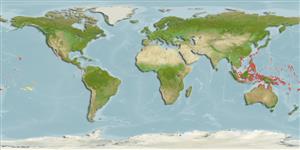Environment: milieu / climate zone / depth range / distribution range
Ekologi
laut berasosiasi dengan karang; nir-ruaya; kisaran kedalaman 0 - 3 m (Ref. 30874). Tropical; 30°N - 18°S
Western Pacific: Southern Japan in Ryukyu Islands and south to northern Queensland, Australia. Has been collected close to the islands in Micronesia, Melanesia, Fiji and New Guinea.
Size / Weight / umur
Maturity: Lm ? range ? - ? cm
Max length : 6.4 cm TL jantan/; (Ref. 117049)
deskripsi pendek
Kunci identifiaksi (pengenalan) | Morfologi | Morfometrik
Duri punggung (Keseluruhan (total)) : 4 - 6; duri punggung lunak (Keseluruhan (total)) : 8 - 13; Duri dubur: 1; Sirip dubur lunak: 13 - 15. Mouth barely protractile and with thin lips. Basihyal and mesopterygoids usually with teeth. No notch present at the anterior border of preopercular bone. Face with Shangreen denticles. Ascending process of premaxilla with no lateral processes present. Distal end of maxilla blunt and truncate.
Loose aggregations inhabit tide pools and rocky shorelines and reef margins. Eggs are large.
Life cycle and mating behavior
Kematangan | Reproduksi, perkembang biakan | Pemijahan | telur-telur | Fecundity | Larva
Myers, R.F., 1991. Micronesian reef fishes. Second Ed. Coral Graphics, Barrigada, Guam. 298 p. (Ref. 1602)
Status IUCN Red List (Ref. 130435: Version 2024-1)
ancaman kepada manusia
Harmless
penggunaan manusia
Perikanan: tidak ada kepentingan; umpan: occasionally
Alat, peralatan
laporan khas
muat turun XML
Sumber internet
Estimates based on models
Preferred temperature (Ref.
123201): 26.2 - 29.3, mean 28.7 °C (based on 1520 cells).
Phylogenetic diversity index (Ref.
82804): PD
50 = 0.6250 [Uniqueness, from 0.5 = low to 2.0 = high].
Bayesian length-weight: a=0.00389 (0.00180 - 0.00842), b=3.12 (2.94 - 3.30), in cm total length, based on all LWR estimates for this body shape (Ref.
93245).
Trophic level (Ref.
69278): 3.4 ±0.45 se; based on food items.
Fishing Vulnerability (Ref.
59153): Low vulnerability (10 of 100).
Nutrients (Ref.
124155): Calcium = 186 [94, 402] mg/100g; Iron = 0.987 [0.515, 1.791] mg/100g; Protein = 19.2 [16.9, 21.6] %; Omega3 = 0.124 [0.050, 0.339] g/100g; Selenium = 13.5 [6.0, 37.3] μg/100g; VitaminA = 331 [96, 1,081] μg/100g; Zinc = 2.16 [1.34, 3.37] mg/100g (wet weight);
